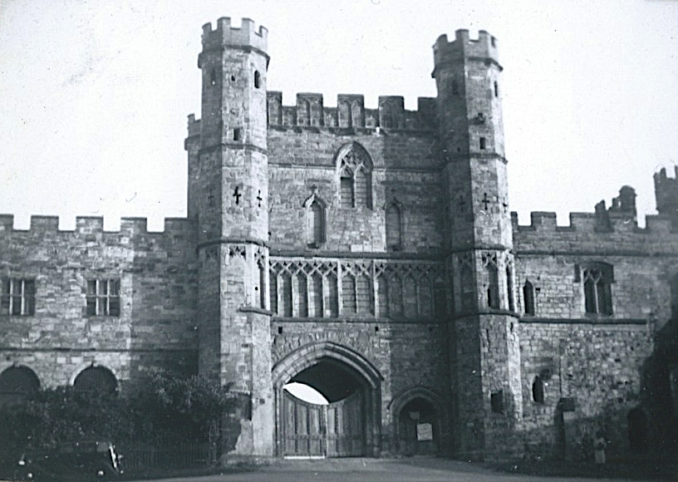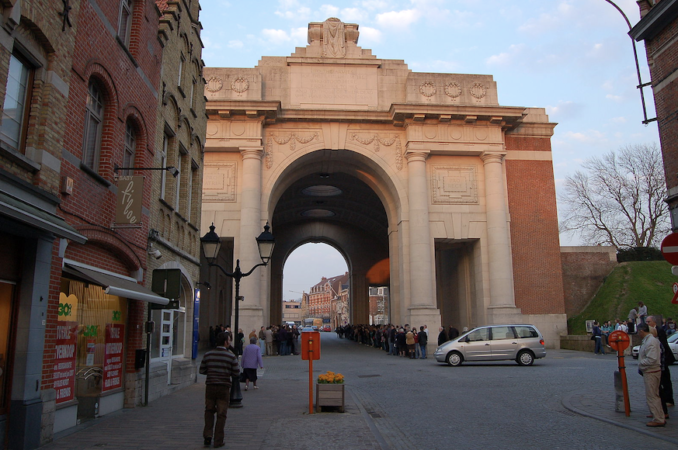Battle Abbey
Battle Abbey, located in Battle, East Sussex, is a partially ruined Benedictine abbey built on the site of the historic Battle of Hastings. The abbey is dedicated to St Martin of Tours and is now operated by English Heritage under the name “1066 Battle of Hastings”. The site includes the abbey ruins, a visitor centre with a film and exhibit about the battle, audio tours, and the monks’ gatehouse with recovered artefacts.
The abbey was founded by William the Conqueror who promised to build an abbey at the battle site, with the high altar positioned on the supposed spot where King Harold fell. Granted many privileges, the abbey was remodelled in the late 13th century. However, it was significantly destroyed during the Dissolution of the Monasteries in 1538 under King Henry VIII. After changing hands multiple times, it was eventually bought by Sir Augustus Webster in 1901 for £200,000.

© Always Worth Saying 2023, Going Postal
Sir Augustus (son of Sir Augustus, 7th Baronet) was born in 1864 and succeeded his father as 8th Baronet in 1886. In 1976, Augustus Webster’s heirs sold Battle Abbey to the British government, and it is now in the care of English Heritage.
Today, visitors can experience the historical battlefield where William the Conqueror and King Harold clashed in 1066. The site provides interactive exhibitions, carved wooden sculptures, a medieval-themed playground, and a walled garden. It’s possible to book a visit online with prices starting from £14 per adult.
The Battle Abbey Websters
As for Sir Augustus, the 8th Baronet, properly monikered Sir Augustus Frederick Walpole Edward Webster (1864–1923), OBE, JP, Lord of the Manor of Battle and the final baronet, he was one of the Copthall, in the County of Essex, Websters and is not to be confused with the Webster baronets of Alverstone, Isle of Wight.
Educated at Eton, Sir Augustus proceeded to Sandhurst and was commissioned to the Grenadier Guards. A founder of the entertainment troop the Guards Burlesque, he was also a member of the Old Stagers and Windsor Strollers. After twelve years in the Guards, Sir Augustus retired with the rank of captain but re-joined at the outbreak of the Boer War.
After serving for the duration, he remained in South Africa and, at the outbreak of the First World War, returned to England and presented to his old regiment at Chelsea Barracks. He retired again six months after the Armistice with the rank of major and an OBE. However, the fortunes of war still told against him. The Hastings and St Leonard Observer of Saturday, August 18th 1917 carried the following notice:
Death of Lieut Webster – the following notice appears in the casualty list:- Second Lieutenant Godfrey Vassal George Augustus Webster, Grenadier Guards, who has been killed in action was the only son of Captain Sir Augustus Webster Bart. [baronet] also of the Grenadier Guards (Reserve), of Battle Abbey Sussex, and son of the late Lady Webster, who was accidentally drowned last June while attempting to rescue her daughter, who had gone beyond her depth in the water. Born in 1897, he was educated at Sandhurst and joined the Grenadier Guards as a second lieutenant in October of last year.
Second Lieutenant Webster is remembered on the Menin Gate at Ypres.

The Menin Gate viewed from inside Ypres,
Jll – Licence CC BY-SA 2.5
His mother, Mabel, had lost her life a few weeks previously. Bathing in a lake on the grounds of nearby Powder Mill House, less than a mile from Battle Abbey, sister Evelyn got into difficulties. Lady Webster swam to her assistance. A governess tried to reach the pair by boat but after losing an oar was forced to jump into the lake and swim to the girl who clung to her while the pair struggled ashore. However, of Lady Webster there was now no sign. Four hours later her body was recovered when the police dragged the lake.
With one other sibling also a daughter and Godfrey dead, the baronetcy became extinct in 1923 when Sir Augustus died at the home of a Brighton masseuse aged only 59.
Referring to the old family album photograph, taken during my grandparents’ visit to Eastbourne in 1948, a lady stands in the gloom to the right, a little black car to the left. Battle Abbey gatehouse looks somewhat shut and run down, as well it might have been given that during the war it had been a billet for Canadian troops, before that – a girl’s school.
If my grandparents visited on Wednesday 18th August 1948, they could have attended the Battle Abbey flower show. Between 1:30 pm and 4:30 pm, admission was 2/- after which, and until 7 pm, it was 1/-. Children under 12 were admitted for half price and at 7 pm many exhibits were sold by auction in aid of local charities. Better times.

© Google Street View 2023, Google.com
My grandparents took their photograph from the Abbey Green, beside a High Street which is also the A271 to Hailsham for Eastbourne. In the modern day we can stand in the same spot. The view is much the same. Puffins can see for themselves via this link.
Wilmington Long Man
A detour west of Eastbourne on the A27 takes us to our next destination, the Long Man of Wilmington which sits on a hillside near the village of the same name. By the miracle of Street View it is possible to read the sign beside the path at the foot of the Long Man. It states:
The Long Man of Wilmington: One of the greatest mysteries of the Sussex countryside, the Long Man of Wilmington stands 70 metres high (231ft). This is equivalent to the height of 40 men!
The earliest known reference to the Long Man suggests the original figure was a marking in the grass rather than a solid line. During the Victorian period the shape was marked with yellow bricks, more recently replaced by concrete blocks.
The Long Man is best viewed from a distance. Aerial photographs show the true shape of the Long Man is elongated though from the ground he assumes normal human proportions. For more information on the Long Man visit Sussex Past.
Beneath that is a long list of ‘don’ts’ which approximate to ‘now go away.’ Also known as the Wilmington Giant, this intriguing hill figure is situated on the steep slopes of Windover Hill, near Wilmington, East Sussex. This figure, the largest human portrayal in Europe, is one of the two major extant human hill figures in England – the other being the Cerne Abbas (rude) Giant in Dorset.

© Always Worth Saying 2023, Going Postal
The origins of the Long Man are shrouded in mystery. Originally believed to have originated in the Iron Age or Neolithic period, it was later suggested after a 2003 archaeological investigation that the figure might have been created using white-painted breeze blocks and lime mortar during the Tudor or Stuart era. Perhaps the figure could have been a political satire piece or a religious image associated with the Reformation during this time?
Throughout its history, the Long Man existed merely as a shadow or an indentation in the grass until it was reconstructed in 1873-74 with yellow bricks whitewashed and cemented together. In 1969, these bricks were replaced with concrete blocks, maintaining the figure’s visibility from miles away.
The enigmatic figure continues to baffle archaeologists and historians, with theories about its origins ranging from a fertility symbol to an ancient warrior. However, as the noted local historian the Reverend A A Evans said, “The Giant keeps his secret and from his hillside flings out a perpetual challenge.” The Long Man of Wilmington is indeed a fascinating piece of England’s historical and cultural tapestry.
The Long Man is found at the end of a public bridleway on the road out of Wilmington and it was along this path that my grandparents took the photo. You can look around in the modern day here.
The big difference being that a scruffy bit of land only fit for a few coos is now laid out for barley with occasional bad weather leading to sheep being driven to graze on the higher land. This townie was very pleased with himself when he correctly guessed at barley but he was wrong anyway. A friend informs me it is malting barley. Further investigation revealed a Mr Duncan Ellis of Church Farm, Littlington, harvests the crop which is destined to be used by the nearby Long Man Brewery for their traditional Sussex ales.
Good luck to him.
Wilmington Village
In nearby Wilmington village, there is a car park for pedestrians wishing to access the bridleway. Nearby in the grounds of St Mary & St Pater’s church stands an ancient yew tree, so ancient it has to be held up with poles. Thought to be 1,600 years old, the Woodland Trust has placed the Wilmington Yew on its England Tree of the Year shortlist.
According to the local Argus newspaper, Churchwarden Mr John Marshall has tended the Wilmington Yew for 25 years. The 82-year-old told The Argus the yew is “splendid” and deserves to be named the country’s best. The ancient tree is believed to have been planted by pagans in about 400 AD. More than 600 years later, St Mary and St Peter’s Church was built next to it in the aftermath of the Norman Conquest.
On the top of the hill above the Long Man, and visible on the horizon in the old photograph, there appears to be a ringed depression – as if evidence of some kind of pre-historic structure. I am grateful to Mr Alex I Askaroff who explains,
We know that just above the Long Man of Wilmington there are old flint pits used by Neolithic man and a chalk pit used by the Romans to make their favourite building ingredient, concrete. There are flint pits above him and even older Bronze Age Long-Barrows on Windover Hill. Also to the left of the giant are more chalk pits. So we can see all around that humans have been busy.
The Long-Barrows above the Long Man of Wilmington are from the Bronze Age. Some say that the largest Long Barrow in Sussex must have something to do with our giant, even though that would mean him over 1,500 years older than some say he is.
What an interesting place! More of which’s fascinating history can be found on Mr Askaroff’s website.
© Always Worth Saying 2023



